"Fall of Free Expression" (2015)
Watercolor and ink painting depicting the threat to freedom of expression in the world, in society, in culture, and under oppressive governments. This freedom is crumbling and reflected in the shadows of vulnerable, multicolored dominoes. This piece demonstrates use of a vanishing point beyond the page.
More from this Category:

"Indo-Chinese Classical Dance: Draft" (2024)
Drawn with ink. Each dancer is based on reference photographs of traditional Chinese classical dance costumes and traditional Indian classical dance/music costumes (Bharatanatyam, Odissi, Carnatic). Motifs associated with each culture, including a parasol and a sitar, are included. Each figure's costume, makeup, hairstyle, and accessories is distinct. Figures are arranged and layered on the poster to show people sharing classical arts and cultural spaces with each other. Motifs of the moon and the stages of love, which was the showcase theme, is included to the bottom left (moon phases) and bottom right (small hearts). Symmetry and balance was achieved by keeping figures in parallel poses and parallel colors. Finally, the cursive script used for the description stands in contrast with the showcase information, title, and the dance clubs' names (Mei-Kala). A bold, curved script was used to match the curves and angles of the performers' bodies. See "Indo-Chinese Classical Dance" (2024) to see final version of this poster.

"Peacock Deities" (2020)
Drawn in ink. Commissioned for a couple's anniversary: the wife was named for Vidhya Devi or Saraswati, the Hindu goddess of wisdom (figure on the right); the husband was named for Kumara or Karthikeya, the Hindu god of war (figure on the left). Both Kumara and Vidhya have a peacock as their vehicle, so the peacock was used as a unifying symbol between the figures. Vidhya is shown with lotuses by her ears, carrying a veena, a stringed classical instrument, with a third eye on her forehead to mark her spiritual knowledge. Kumara carries a spear with his father's symbol on his forehead and on the spearhead. They lean towards each other, and the arc of their bodies and their instruments are meant to create a general sense of symmetry with the peacock feathers. They also have halos around their heads. Their limbs are drawn stylistically, in a cartoonish manner. Sharp angles and thick, flowing lines are featured in both their garments.

"Savitri" (2019)
Drawn in ink and pencil. This sketch is of the famous South Indian Telugu actress, Savitri (1934-1981) who dominated the South Indian film industry in the 50's and 60's. This illustration of her is taken from a scene in one of her film's songs, in which she stands decked in a sari, her hair adorned with a halo of jasmine flowers, a high hairbun, and a long, signature bottu/bindi on her forehead. She was easily recognizable via her distinct beauty: an oval-shaped face and wide eyes lined with kaatika (kohl). Hence, her style and features were the focus of this sketch.
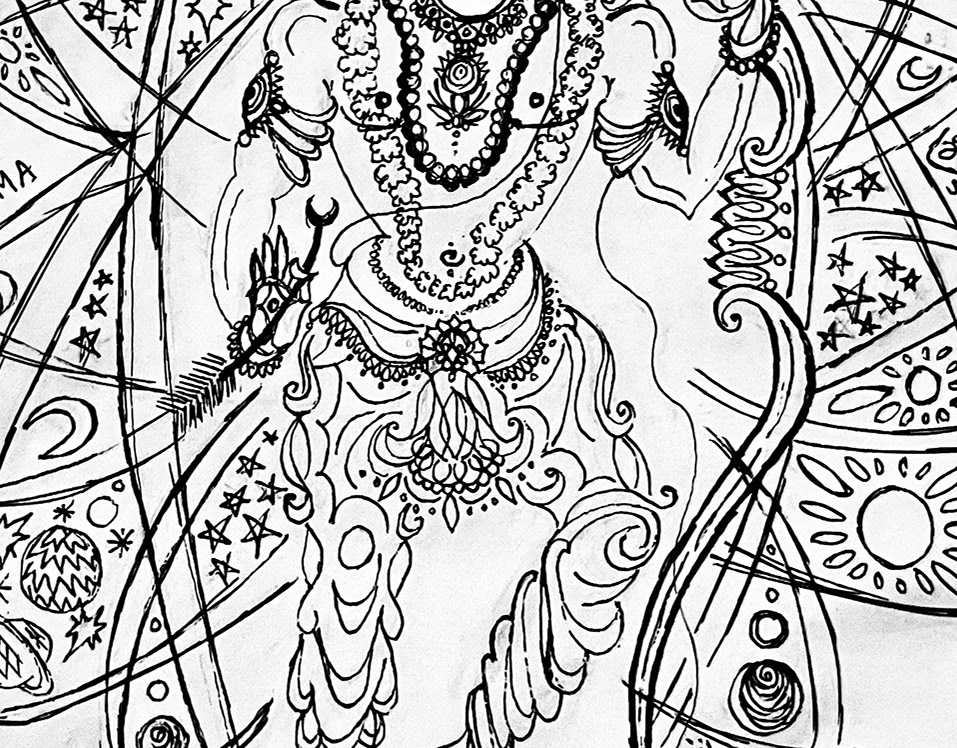
"Universe, Balance: Rama" (2023)
Created with ink, draft (scroll down) created with pencil. This illustration depeicts the Hindu god Sri Rama as the center of the universe, providing balance between opposing sides. He carries an arrow (with a crescent-shaped head, similar to that of ancient Indian arrows, which had different shapes) and bow whose string curls around his arms. His crown, belt, and jewelry indicate his status as a warrior king, and a sun-like halo surrounds his head. His forehead is covered in the symbol of the god Vishnu, whom he is the incarnation of. His pants are drawn stylistically to show draped silk. His feet have small sparks next to them. He is surrounded by a structure which contains suns and moons, planets and stars. Rama's name, in English, Telugu, and Hindi, is written amongst these parts of the universe. The structure symbolizes both the universe and an atom: to suggest that Rama is present in the largest scale and smallest scale. In this illustration, centering him within the smallest particle is a reference to Telugu poet Annamacharya's writing on the same subject. Finally, the sacred syllable "Om" outlines the structure. Note: This piece was intended to be the first in a series of illustrations for a devotional kirtan (song) about Rama, written by the late Dr. Advikolanu Muralidhar. So, this imagery reflects the lyrics. This style of art is inspired by the Vedic Art style, hence the curved body of the male figure, the oval-shaped face, and elaborate ornaments.

"Self-Portrait in St. Petersburg" (2015)
Freehand pencil sketch using 4B and HB pencils. Drawn on a train from Moscow to St. Petersburg, with focus on blocks of unblended shadows and looser, flowing shapes. The goal was to blend realistic and surrealistic styles between face and hair. The linework outlining the profile purposefully thins and thickens to create delicacy.

"The Suicide Pact" by Dr. Advikolanu Muralidhar (2021)
Book cover and jacket designed using Adobe Illustrator for "The Suicide Pact," an English play by Dr. Advikolanu Muralidhar, a South Indian Telugu poet and writer. The central lesson is highlighted on the back cover. Each element from the set design and the themes/events themselves are illustrated. The play centers on a professor and his artistic wife, Lalitha, who despise one another, themselves, and their lives. One night, they draft a suicide pact. Since the play occurs over one night, the book spine, and the book cover's ceiling fan contains a single moon. The ceiling fan, with a sari and tie hanging from it, implies potential death looming over the characters' heads. The eye in the fan represents the audience bearing witness, who ultimately decide the story's conclusion. One line from the fan spirals into two, connecting to "U" and "I" to symbolize individuals, once united in love, now estranged. The wall has several symbols: There are two portraits of a hanging, one with and one without the head attached, to show both potential conclusions to the story. There is Lalitha's scribble next to the hangings, as she laments the meaninglessness of art and art critique. A sketch of a mother and child is drawn by Lalitha yet slashed to show her lost dream of motherhood. A question mark and quotation marks show how the majority of the play is dialogue with existential questions. The quotation marks also hint at the professor's monologue about the pointlessness of speech. A cage from the set design provides a feeling of being trapped in marriage/life. Cigarettes, a watch, a fountain pen, bangles, an ashtray and the suicide pact itself, are laid out on a table. The mangalsutra (wedding necklace) lies discarded, to show the dissolvement of marital bonds. The professor's glasses are cracked, to show distorted perspectives. The table doubles as the Bombay apartment where the characters reside, with shattered windows on one side and windows with the words "You, Me" scribbled on in Telugu. "You, me" is a phrase repeated when the characters are in love, yet those words change their meaning that night. The last letter of "Me" and the first letter of "You" are the same in Telugu, hence they merge initially (to symbolize unity in love) and gradually separate and reflect (to symbolize distortion of the self and separation in marriage) on the apartment and on the back cover's lower border.
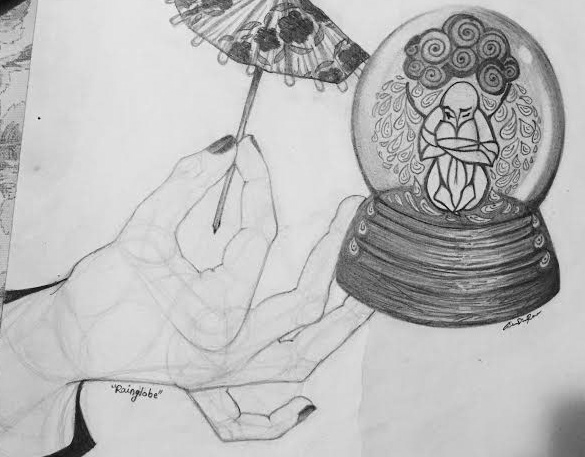
"Rainglobe: Trapped Angel" (2016)
Illustrated with pencil for a Drawing class assignment, in which students were instructed to create a piece that incorporated a hand, an object, and glass. Thus, this illustration is of a small, isolated, angelic figure trapped in a globe. A raincloud in the globe showers onto them, and the feathery drops turn into wings. Hence, the title of the piece. Meanwhile, outsiders attempt to offer comfort, represented by a hand holding a cocktail umbrella up to the glass. However, their efforts are futile; the figure is beyond their reach, and it will take more than a frail umbrella to shatter the glass. The figure, drafted in the second image below (you'll see it when you scroll down), has wrapped their limbs into a near-fetal position. They peek out at the hand, at the comfort being offered, but do not engage with it. Note the use of shading in the glass and wooden base of the globe, the high contrast of the figure's outline, a spot of light upon the glass, and the mechanical drawing style of the hand which breaks it into its simplest forms.
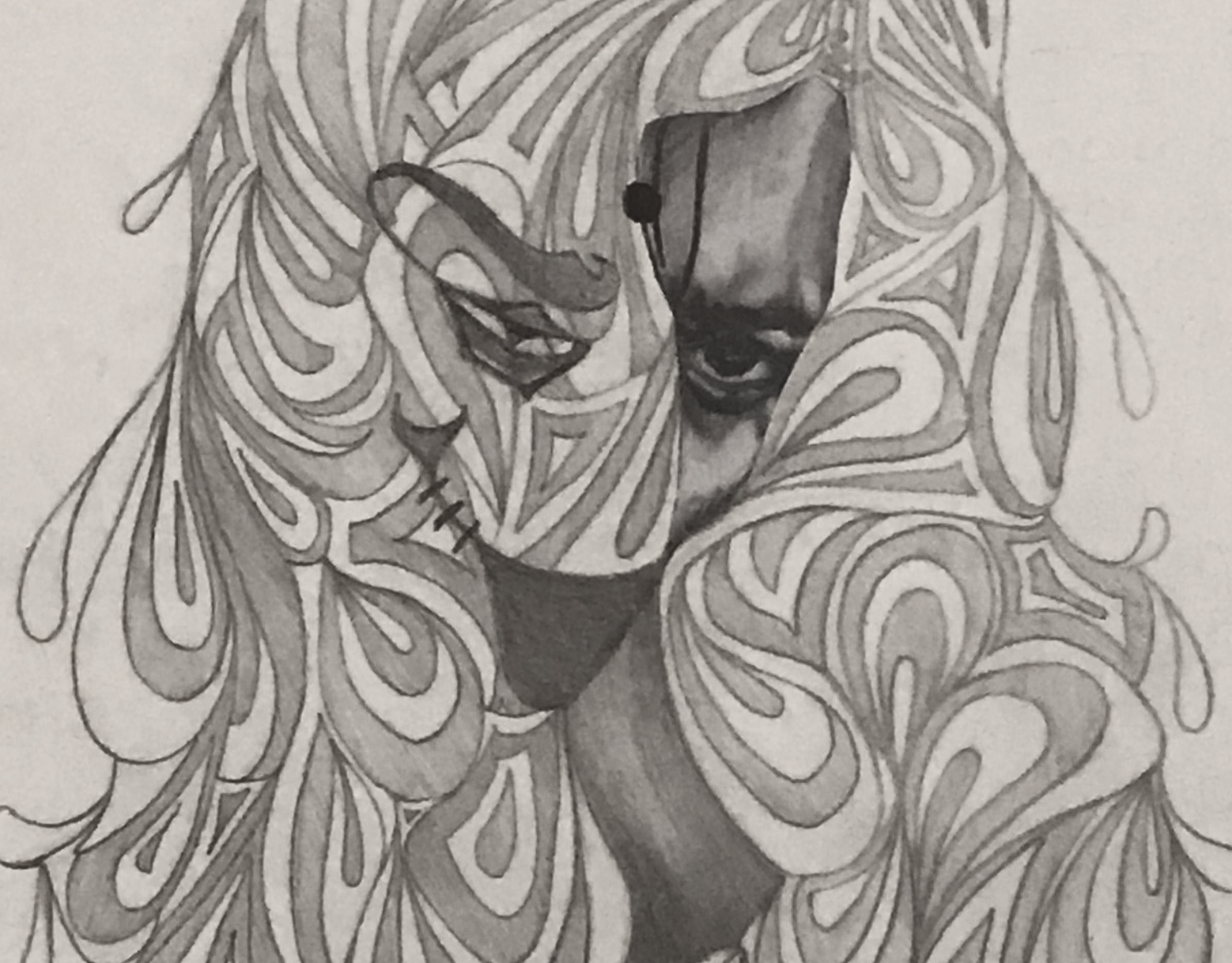
"Outer Animal, Inner Anguish" (2016)
Pencil drawing created for Drawing course. Displayed at Anglo-American School of Moscow. Realistic sliver of a face shows a tortured inner self, fighting for control inside the mind of a monstrous external self, shown with the cartoonish outer eye and stitched smile. A bindi/bottu holds both the external and internal self together, at the seams. The hair is drawn stylistically, with fluid shapes and slight curves fitted next to triangles.
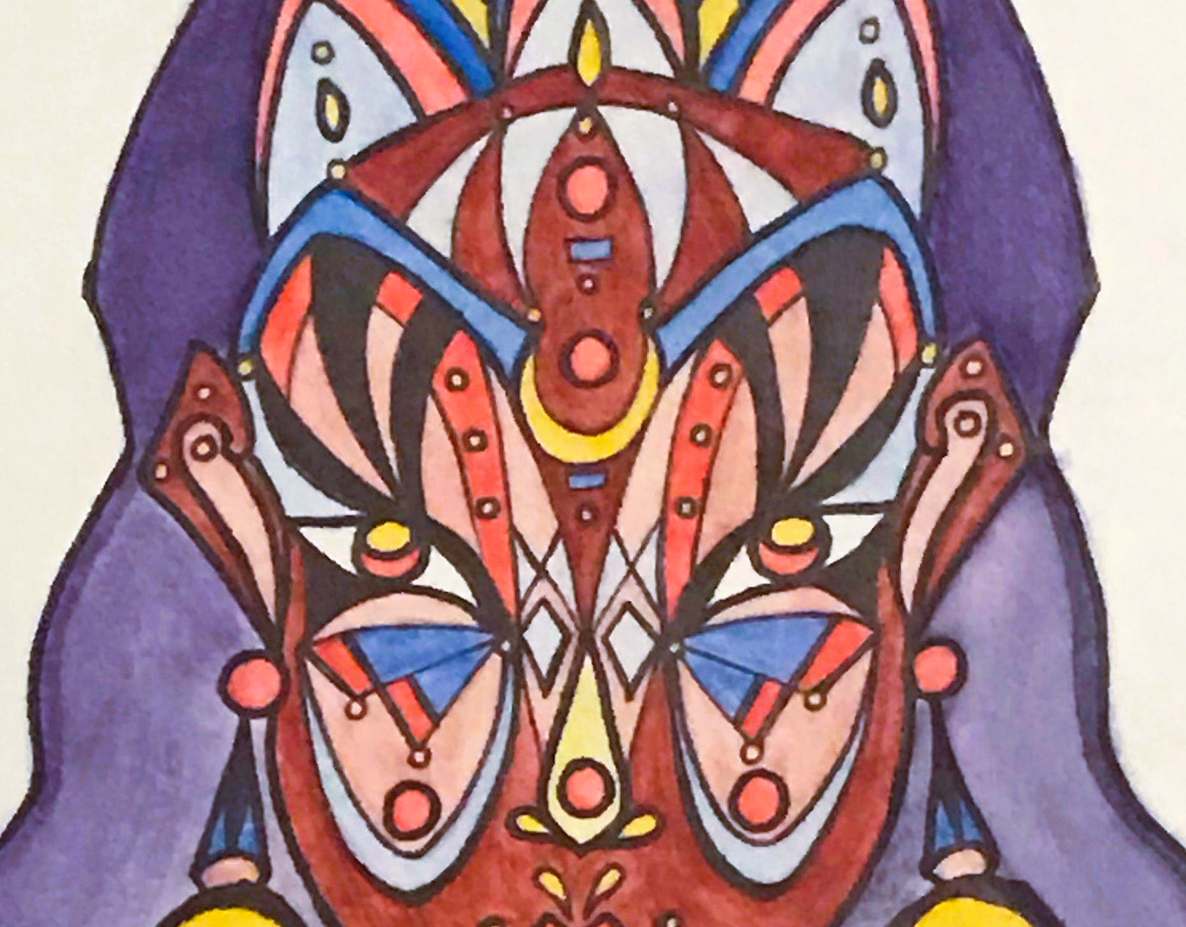
"Crescent Woman" (2014)
Watercolor pencil and ink painting of a woman, inspired by traditional African masks and South Indian Tamil style bottus (spiritual third eyes and marks of which Hindu deity one worships). This features the artist's love for finding and bringing out symmetry with geometric shapes in human faces, namely focusing on crescent, circular, and triangular shapes. Style is also influenced by Bapu, a South Indian Telugu artist who worked with bold colors and continuous lines.
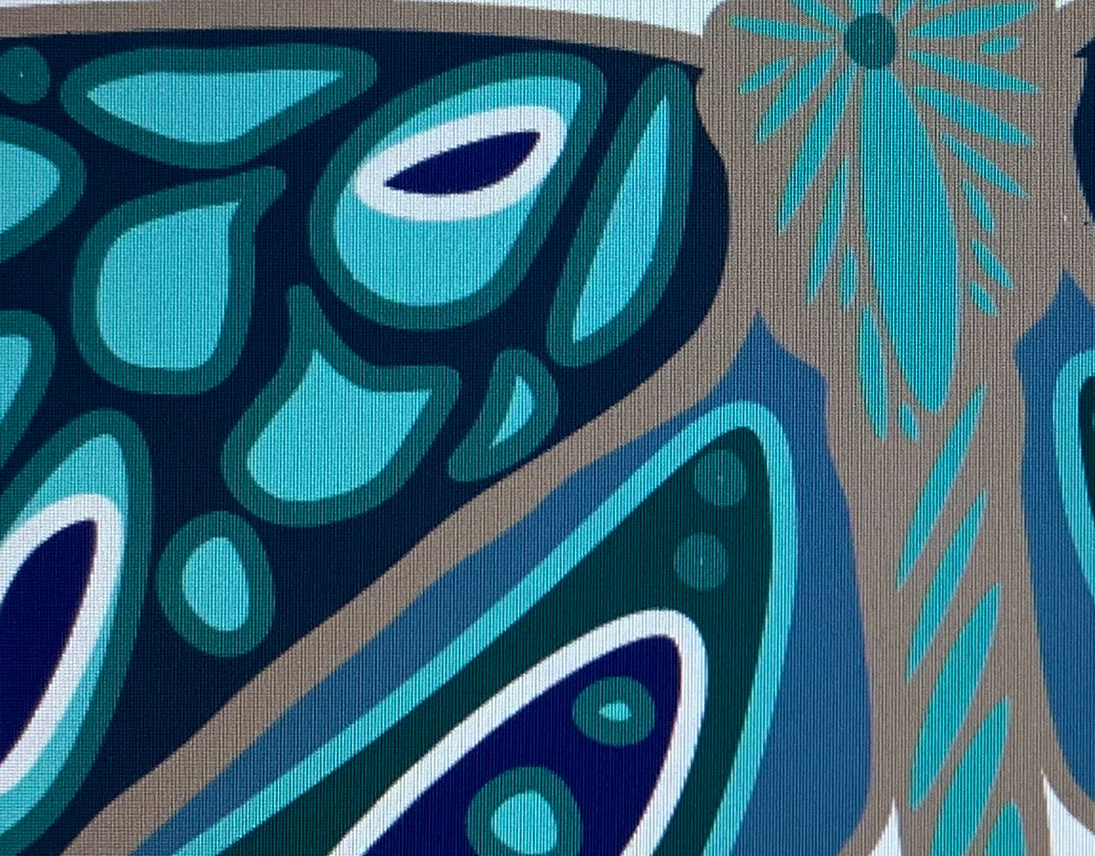
“Blue Butterfly” (2020)
Created using Adobe Illustrator as part of Visual Design & Digital Making Virtual Summer Intensive, co-sponsored with LITS at Bryn Mawr College. This is from a course exercise on symmetry and patterns. Shapes are nestled within one another, and the body of the butterfly contains a floral burst.